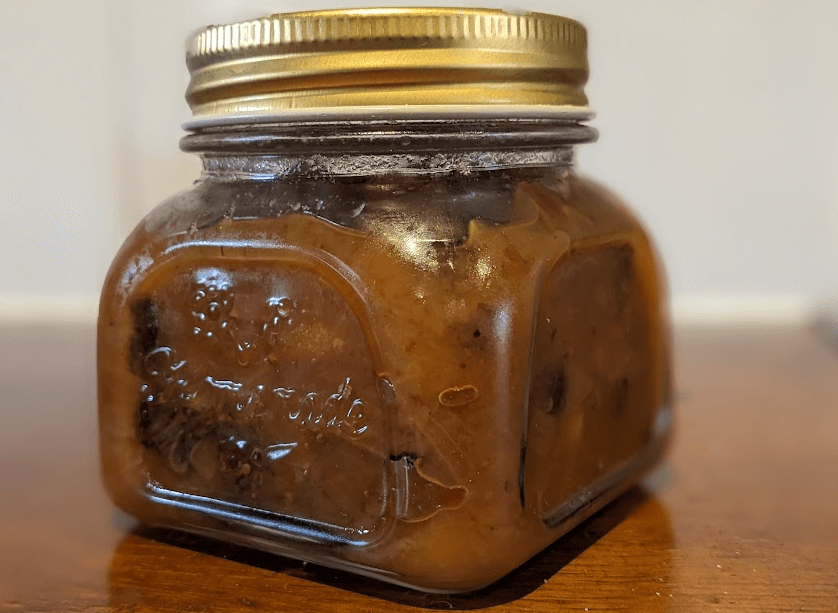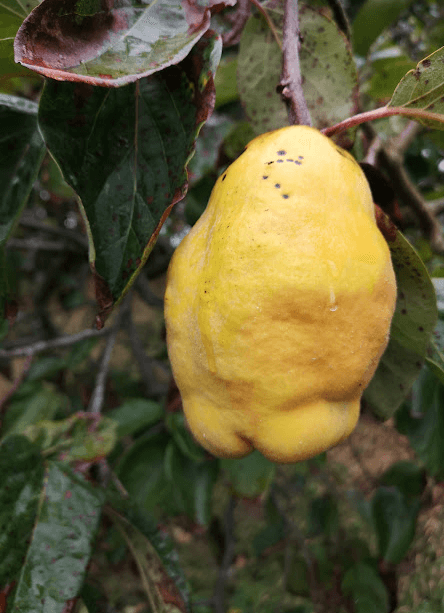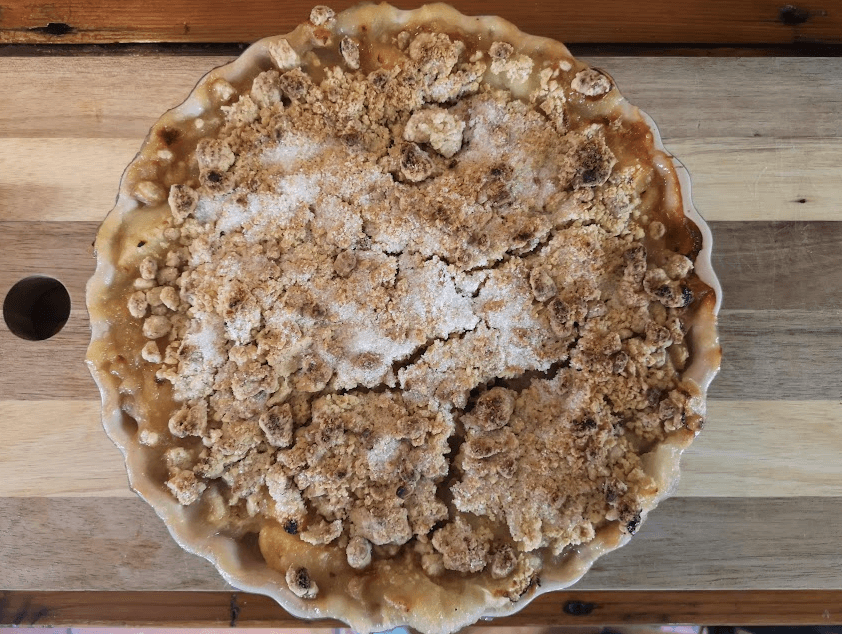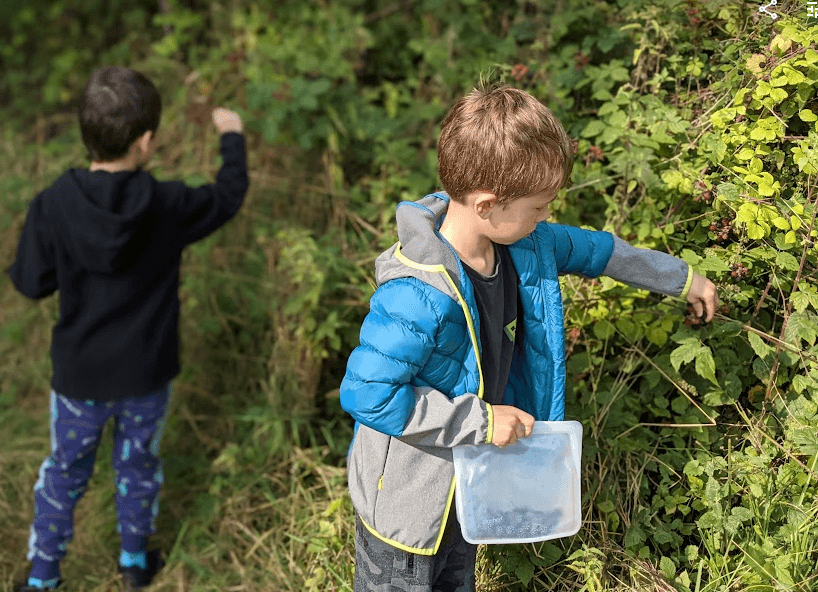Frugal Nature: Foraging Recipes in the UK
In a fast-paced digital age, where screens often dominate our leisure time, there’s a delightful way to reconnect with nature, foster quality family moments, and nourish both body and soul. Welcome to the world of foraging for recipes in the UK – an enchanting pursuit that not only allows you to discover the edible treasures in your locality but also offers an active escape from the digital stare. As a dad, I’ve really grown to understand the importance of meaningful experiences with my boys, and foraging for recipes with a simple kit or bag presents a wonderful opportunity to create lasting memories while enjoying the natural abundance around you – without the need to spend a fortune on “stuff”.
Foraging isn’t just about gathering ingredients; it’s a journey of exploration, discovery, and connection. As you venture into local woodlands, meadows, and hedgerows, accompanied by your eager little foragers, you’ll unravel the hidden gems that nature has to offer and discover new locations, paths, and trails you never knew existed. The thrill of identifying edible plants and fruits, the joy of harvesting your finds, and the satisfaction of transforming them into delicious meals – all of these moments contribute to a rich tapestry of valuable shared experiences for families.
Beyond the tangible rewards, foraging is a gateway to holistic well-being. It’s a chance to escape the confines of screens and embrace the sensory marvels of the outdoors. The tranquility of the natural world, the soothing rustle of leaves underfoot, and the earthy scents that envelop you – these are the elements that rejuvenate both young minds and grown-up spirits. As I’ve started to teach my boys to differentiate between a dead nettle and a wild mint, I’ve also been hoping the nurturing a sense of curiosity, respect for nature, and an appreciation for the simple yet invaluable things that the UK’s landscapes offer.
Whilst most of our foraging has been in the Norfolk, Suffolk, and Breckland areas, this article serves as an accessible way into foraging in the UK with children. We’ll dive into the enchanting details of five distinct foraged ingredients – dead nettle, sloe, quince, wild mints, and sweet chestnut. Each ingredient comes with its own story, identification tips, and a delectable array of culinary possibilities. We’ll also explore the basics of assembling a foraging kit and bag that equips you and your family for successful foraging escapades.

So, before we dive into five easy-to-identify foraged favourites of ours, let’s just lay out some simple, but important ground rules:
- Baby, Think Thrice!- Triple-check plant identification before use; apps like PlantNet and local Facebook groups aid in accurate recognition.
- Respectful Harvesting – Gather only what’s needed, leaving ample for wildlife and future generations. Avoid pulling bulbs/roots.
- Preserve Habitats – Avoid damaging plants and ecosystems; tread lightly and stay on designated paths. Apps like C:Geo and Strava help learn about your local routes and land.
- Stay Informed – Comply with local regulations, seek landowner permissions, and prioritise safety at all times. Also, be aware of growing trends like the prevalence of ticks in long grass and dress appropriately.
- Knowledge is Key – Educate yourself about poisonous look-alikes; if unsure, don’t risk consumption. Whilst I encourage you to get out and about with your family, this article is not advice for you to follow our journey without thought. Please make your own decisions based on your own research and confidence levels.
UK Foraging Tips and Recipes for Dead Nettle: Unveiling the Edible Beauty
As you step into the realm of foraging with your family, one of the first enchanting discoveries you’ll make is the versatile dead nettle. Despite its mortifying name, this common wild plant is anything but lifeless – it’s a vibrant and edible herb that adds a touch of wild wonder to your culinary pursuits.

Dead Nettle Identification and Foraging Habitat
Dead nettle is characterised by its heart-shaped leaves and clusters of trumpet-like flowers that range in color from pink to white. Often found in hedgerows, woodland edges, and gardens, dead nettle thrives in moist and shaded areas across the UK. It is the lack of stinging hairs on the leaves and stems that set it apart from its close relative, the stinging nettle.
Foraged Nettle Tea Recipe: A Soothing Brew for All Seasons
One of the simplest and most rewarding ways to enjoy dead nettle is by brewing a fragrant nettle tea. Nettle tea is known for its mild and earthy flavor, as well as its potential health benefits. Here’s how you can create a comforting cup of nettle tea for you and your family:
Foraged UK Ingredients for Dead Nettle Tea:
– Fresh dead nettle leaves (about a handful)
– 2 cups of water
– Honey or lemon (optional, for flavour)
Instructions:
1. Begin by harvesting fresh dead nettle leaves. Choose leaves that are vibrant green colours and free from damage. Avoid yellowing or browning leaves.
2. Gently rinse the leaves under cold water to remove any dirt or debris.
3. In a saucepan, bring 2 cups of water to a gentle boil.
4. Add the washed dead nettle leaves to the boiling water and allow them to steep for about 5-7 minutes. Steeping time can be adjusted based on your preference for strength.
5. Once the tea has steeped, strain the leaves and pour the nettle tea into cups.
6. For a touch of sweetness or extra flavour, you can add a drizzle of honey or a squeeze of lemon.
Nettle tea is renowned for its potential health benefits. Rich in vitamins, minerals, and antioxidants, it’s believed to have mild diuretic and anti-inflammatory properties. Nettle tea is also known for its potential to support digestion and promote overall wellbeing. It’s also a great place to start with picky eaters as there’s little flavour, hence the option to add lemon or honey. It’s also great as a bushcraft or campfire activity if you’re camping as a family.
Once you have your freshly brewed nettle tea, take a moment to revel in the connection between nature and your taste buds. Let the gentle earthiness of the nettle leaves transport you to the very spot where you harvested them. Whether enjoyed warm on a cozy evening or chilled over ice on a sunny day as part of an afternoon tea, nettle tea encapsulates the essence of foraging – a blend of nature’s gifts and the joys of culinary creativity.
With your newfound knowledge of dead nettle and its enticing tea as a starting point, you’re ready to dive deeper into foraged ingredients that the UK has to offer. Read on for foraging recipes including the use of sloe, quince, wild mint, and sweet chestnut, each with its own distinct story and culinary possibilities.
UK Foraging Tips and Recipes for Sloe: Beyond Gin-Making
Moving forward with our UK family foraging journey, we’re looking next at the sloe. The world of sloes opens up to reveal a treasure trove of possibilities beyond the familiar realm of adult-orientated gin-making. These small, bluish-black berries are not only sought after for their role in creating the iconic sloe gin but also for their unique and versatile culinary applications. So, what are their distinct characteristics, preferred habitats, and potential recipes?

UK Sloe Identification and Foraging Habitat
Sloes, scientifically known as Prunus spinosa, are small, plum-like fruits that adorn thorny shrubs. They are typically found in hedgerows, woodland edges, and scrubby areas across the UK. Sloes are known for their deep blue-black hue and their characteristic bloom, which gives them a slightly frosted appearance (similar to a miniature plum). While sloes are famously associated with a traditional tipple, let’s explore a creative recipe that showcases the rich flavour of sloes in a delightful way:
Foraged UK Sloe Recipe: Sloe and Apple Chutney
This vibrant and tangy chutney pairs the natural sweetness of sloes with the crispness of apples, resulting in a versatile condiment that complements a variety of dishes.
Foraged UK Ingredients for Slow & Apple Chutney:
– 1 cup sloes, washed and pitted
– 2 cups apples, peeled, cored, and chopped (Windfall are fine)
– 1 small onion, finely chopped
– 1/2 cup brown sugar
– 1/2 cup apple cider vinegar
– 1/2 teaspoon ground cinnamon
– 1/4 teaspoon ground cloves
– Pinch of salt
Instructions:
1. In a saucepan, combine the sloes, chopped apples, and onion.
2. Add the brown sugar, apple cider vinegar, ground cinnamon, ground cloves, and a pinch of salt.
3. Stir well to combine all the ingredients.
4. Place the saucepan over medium heat and bring the mixture to a gentle simmer.
5. Reduce the heat and let the chutney simmer for about 30-40 minutes, stirring occasionally, until the mixture thickens and the fruit breaks down.
6. Once the chutney has reached your desired consistency, remove it from the heat and let it cool.
7. Transfer the chutney to sterilised jars and seal them tightly.
8. Allow the chutney to sit for a few days before using, as this allows the taste of the wonderful contents to mature and mingle into a foraged marvel!

Your homemade foraged sloe and apple chutney is ready to add a burst of flavor to your meals. Spread it on sandwiches, serve it alongside roasted meats, or use it as a glaze for grilled vegetables or on a joint of meat. The sweet and tart notes of sloes, combined with the warm spices, create a symphony of tastes that elevate even the simplest of dishes.
UK Foraging Tips and Recipes for Quince: Nature’s Fragrant Treasure
Your foraging journey now leads you to the captivating world of quince – a fruit that exudes a fragrant allure and has been cherished for centuries. As you explore the charming landscapes of the UK, you’ll come across this aromatic treasure, nestled among the bounties of nature. Let’s unravel the mysteries of quince, discover its preferred habitats, and indulge in a classic UK favorite recipe: quince crumble.

Identification of Quince in the UK and Foraging Habitat
Quince (Cydonia oblonga) is a distinctive fruit with a history rooted in tradition. Known for its golden-yellow hue and irregular shape, quince emits a captivating aroma that hints at its culinary potential. Quince trees are often found in orchards, gardens, and even abandoned spaces, thriving in the UK’s temperate climate. You may find some ornamentally used around car park borders of shrubberies, but the more mature, heritage varieties are often a thing to behold – if you’re lucky enough to find these pear-shaped beauties.

Foraged Recipe: Quince Crumble
Quince crumble is a slightly floral twist on the classic UK crumble, encapsulating the essence of cosy indulgence – ideal for autumn and winter dishes. This heartwarming dessert combines the unique flavor of quince with the irresistible texture of a buttery crumble topping. Here’s how to create this delightful quince crumble:
Ingredients for Foraged Quince Crumble
– 4 medium quinces, peeled, cored, and sliced
– 1/2 cup granulated sugar
– 1 teaspoon lemon juice
– 1/2 teaspoon ground cinnamon
– For the crumble topping:
– 1 cup plain flour
– 1/2 cup rolled oats
– 1/2 cup brown sugar
– 1/2 cup unsalted butter, cold and cubed
– Pinch of salt
Instructions:
1. Preheat your oven to 350°F (175°C).
2. In a mixing bowl, combine the sliced quinces, granulated sugar, lemon juice, and ground cinnamon. Toss to coat the quince slices evenly. If you’re quince is particularly firm, let the slices soak in a bath of cool water and lemon juice prior to step 3.
3. Transfer the quince mixture to a baking dish, spreading it out into an even layer.
4. In a separate bowl, prepare the crumble topping. Mix the all-purpose flour, rolled oats, brown sugar, and a pinch of salt.
5. Add the cold, cubed butter to the dry mixture and use your fingertips to rub the butter into the dry ingredients until the mixture resembles coarse crumbs.
6. Sprinkle the crumble topping evenly over the quince mixture in the baking dish.
7. Place the baking dish in the preheated oven and bake for about 40-45 minutes, or until the crumble topping is golden brown and the quince filling is bubbling. Add a light dusting of sugar to the top for the last few minutes if you like a sweeter topping – but watch it like a hawk so it doesn’t burn and spoil the dish.
As you take your first bite of quince crumble, you’ll hopefully experience a simple floral tangling of flavors that encapsulates the essence of the UK’s culinary heritage. The tender and aromatic quince slices should work well with the satisfying crunch of the crumble topping, creating a dessert that’s both nostalgic and indulgent. Whether enjoyed warm with a scoop of vanilla ice cream or savored on its own, quince crumble is a testament to the magic that can be created when nature’s treasures meet the art of cooking. Best enjoyed, in our opinion, in a bowl while sitting outside watching the sunset.
UK Foraging Tips and Recipes for Wild Mint: A Refreshing Harvest
Amidst your foraging escapades, you might be lucky enough to find clumps of the invigorating and alluring wild mint family; nature’s own aromatic gems that promise a burst of freshness with every encounter. As you explore the verdant landscapes of the UK, the vibrant wild mints will catch your attention if knocked, crushed or disturbed. We’re lucky enough to have some supplies of wild lemon balm and watermint near us. So, if you’re looking to find some near your home, let’s delve into the world of wild mint, unveil their distinctive varieties, and habitats, and embark on a singy, fresh adventure with a recipe for wild mint sorbet.
UK Identification and Wild Mint Foraging Habitats
Wild mints belong to the Mentha genus and encompass various species, each boasting a unique flavor profile and aromatic charm. You’ll find these delightful herbs thriving in damp meadows, stream banks (this is where our supply is found), and alongside water bodies throughout the UK. Their distinctive square stems, opposite leaves, and aromatic leaves make them easy to identify.
UK Foraged Recipe: Wild Mint Sorbet
When it comes to celebrating the refreshing allure of wild mints, what could be more fitting than a tantalising wild mint sorbet? This invigorating dessert captures the essence of wild mints in a cool and delightful treat. Here’s how you can create this revitalising wild mint sorbet:

Ingredients for the Wild Mint Fraging recipe:
– 1 cup fresh wild mint leaves, washed and stems removed
– 1 cup granulated sugar
– 2 cups water
– 2 tablespoons fresh lemon juice
– Fresh wild mint leaves, for garnish
Instructions
1. In a saucepan, combine the granulated sugar and water. Heat the mixture over medium heat, stirring until the sugar completely dissolves. Allow the mixture to cool.
2. Place the fresh wild mint leaves in a blender or food processor.
3. Pour the cooled sugar syrup over the mint leaves and blend until you achieve a smooth and vibrant green mixture.
4. Strain the mint-infused syrup through a fine mesh sieve to remove any solids, yielding a clear and flavorful syrup.
5. Stir in the fresh lemon juice to the mint syrup.
6. Pour the mint syrup into an ice cream maker and churn according to the manufacturer’s instructions. If you don’t have an ice cream maker, just remove the mix every 2-3 hours for a stir to encourage the sorbet crystals to form.
7. Once the sorbet reaches a creamy consistency, transfer it to an airtight container and freeze for a few hours until firm.
Hopefully, this recipe will let you indulge in a refreshing and tasty wild mint sorbet, perfect for palate cleansing. The sorbet’s vibrant color can be quite light so, if you want a quick burst of dramatic colour, throw in 5-10 blueberries or blackberries to the mix – this will give the dramatic iced-grey colour which we think is unusual and quirky. Whether enjoyed as the aforementioned palate cleanser between courses or relished as a satisfying dessert, wild mint sorbet is a testament to the magic of foraging, where every bite carries the whispers of the wild foraging your family has completed. This was a great favourite with my boys.
UK Foraging Recipes for Sweet Chestnut: Nutty Foraging Adventure
As our foraging expedition continues, the captivating sweet chestnut tree beckons, offering a treasure trove of delectable nuts that carry the essence of autumn. Amidst the UK’s picturesque woodlands and parks, the sweet chestnut tree stands tall, its prickly husks concealing a culinary gem. Not to be confused with the more angry-looking horse chestnut, the world of the sweet chestnut will allow us, in this article, to embark on a culinary journey with a recipe for sweet chestnut flour – a versatile ingredient that adds a nutty twist to your dishes.
Identification and Habitat when sourcing Sweet Chestnuts for Foraging recipes
The sweet chestnut tree (Castanea sativa) is an iconic presence in the UK’s landscapes, renowned for its grandeur and the bounty it offers. Recognisable by their shiny, serrated leaves and spiky husks that “almost” look furry, sweet chestnut trees thrive in woodlands, parks, and even alongside country lanes, offering their nutritious nuts to those who seek them. They’re not as prevalent as the non-edible horse chestnut, but once you’ve identified their leaves and fruits, you’ll be spotting them everywhere on journeys out with the family. It’s worth noting, you’ll need to be quick to get these lovely ingredients for foraged recipes as the squirrels in the UK tend to get to them first!
Foraged Recipes: Sweet Chestnut Flour – A Nutty Delight
Sweet chestnuts are great simply warmed, peeled, and eaten, but transforming sweet chestnuts into flour opens up a world of culinary possibilities. This hearty and nutty flour can be used in a variety of dishes, adding a distinctive flavour and texture. Here’s how you can create your very own sweet chestnut flour from your foraged haul.
Ingredients for Sweet Chestnut Flour
– Fresh sweet chestnuts (as many as desired)
– Water
Instructions
1. Begin by harvesting ripe sweet chestnuts (wear gloves!). Look for chestnuts with intact husks and a glossy brown exterior.
2. Using a sharp knife, carefully make a shallow cut across the flat side of each chestnut, creating an “X” shape.
3. Place the chestnuts in a pot of boiling water for about 15-20 minutes. Boiling helps loosen the inner skin and makes peeling easier.
4. Remove the chestnuts from the boiling water and let them cool slightly – but not completely.
5. Peel the chestnuts while they’re still warm. The combination of boiling and warmth will make the peeling process smoother.
6. Once peeled, spread the chestnuts on a baking sheet and dry them in an oven set to a low temperature (around 200°F or 90°C) for a few hours, until they are thoroughly dried.
7. Once the chestnuts are completely dry, place them in a food processor or high-powered blender.
8. Pulse the chestnuts until they are finely ground, resembling a flour-like consistency.
9. Transfer the sweet chestnut flour to an airtight container and store it in a cool, dry place.
With your homemade sweet chestnut flour in hand, you’re ready to add a nutty depth to your baked goods, use it as a thickening agent in soups and stews, or even incorporate it into gluten-free recipes. Sweet chestnut flour’s rich flavour and earthy undertones elevate your dishes to new heights, plus it smells divine when in use.
Crafting Your Foraging Bag
In the world of foraging, a well-chosen foraging bag is your trusted companion – a vessel that holds not only your harvested treasures but also the memories of your outdoor adventures. If your family ends up embarking on foraging expeditions across the UK, your choice of a foraging bag becomes essential. Let’s explore the key features to consider when sourcing the perfect foraging bag and discover how this practical accessory can enhance your foraging experience.
When selecting or creating a foraging bag, size plays a crucial role. A bag that’s too small might leave you with limited space for your finds, while an overly large bag can become cumbersome. Opt for a bag that strikes the right balance – spacious enough to hold your foraged goodies but compact enough to carry comfortably. Remember, a well-sized bag ensures that you can explore freely without feeling weighed down.

The rugged terrain of foraging demands a bag that can withstand the elements. Look for bags made from sturdy materials that can endure the outdoors. Natural fibers like canvas or jute are durable options, while waterproof linings add an extra layer of protection (but can make some things sweat/wilt. Reinforced stitching and strong straps contribute to the bag’s longevity, ensuring that it can accompany you on countless foraging adventures.
Breathing capability and ventilation are essential to consider. Foraging often involves collecting freshly harvested plants and fruits, which may still retain moisture. A breathable foraging bag prevents moisture buildup, reducing the risk of mold or spoilage. Look for bags with mesh panels or designs that facilitate proper airflow. This thoughtful feature not only preserves the quality of your finds but also contributes to a more enjoyable foraging experience.
Imagine wandering through meadows and woodlands, hands-free to explore and harvest. Sounds great, right? A foraging bag with adjustable straps allows you to wear it comfortably, distributing the weight evenly across your shoulders. Padded straps and back support enhance your comfort, allowing you to focus on the joys of foraging rather than discomfort.
If you’re a conscious forager, you may wish to align your bag choice with sustainable practices. Opt for bags made from eco-friendly materials, supporting brands that prioritise ethical production. Consider reusable options that reduce single-use waste and leave a positive impact on the environment you cherish. You can check out some green storage options in our save money, cut carbon articles – such as the Stasher Bags which are ideal for berries.
Crafting your ideal foraging bag can also be a green and rewarding endeavour that enhances your foraging adventures. Whether you choose to purchase a thoughtfully designed bag or embark on a DIY project, your foraging bag becomes an extension of your passion for nature and exploration. With your bag in tow, you and your family are almost equipped to gather the bounties of the UK’s landscapes. But check out our other suggestions for a foraging kit below.
Assembling the Ultimate Foraging Kit
As a dad exploring the world of foraging, I’ve found out via many rookie errors that assembling a well-equipped foraging kit is essential for a successful grand foraging adventure. Just as a seasoned explorer stocks up on essentials before embarking on a journey, your foraging kit ensures you’re ready to navigate the landscapes of the UK in search of edible treasures. So, what’s needed for a successful and safe foraging experience?
A Guide/Map/Glossary of Finds – A reliable field guide is your compass in the world of foraging. Choose a guide that’s specific to the UK’s flora, allowing you to identify plants, fruits, and herbs with confidence. Illustrated guides with clear photographs or drawings aid in accurate identification, ensuring that you gather only what’s safe and edible. You can check out more child-friendly guides and printables on sites like The Woodland Trust.
Gloves – While the tactile connection with nature is one of foraging’s joys, gloves offer protection from prickly thorns, stinging plants, and potential allergens. As someone who loves tactile art experiences, I opt to protect my hands wherever possible with simple weeding gloves that usually only cost around £2-3. Opt for sturdy gloves that strike a balance between dexterity and safeguarding. With the right gloves, you and your family can explore diverse habitats without worry.
Small Harvesting Tools – A compact set of tools simplifies the foraging process. Include small harvesting scissors or shears for cleanly snipping leaves and stems. Whilst some sites and books suggest a lightweight knife with a sharp blade for safely collecting fruits or nuts, I think ratchet shears/secateurs should do.
Containers and Bags – The treasures you gather during foraging deserve safekeeping. Reusable containers or biodegradable bags are essential for storing delicate finds and preventing damage during transit. Consider containers with secure lids to prevent spillage and preserve the freshness of your harvest.
Notepad and Pencil or App – Jotting down notes, observations, and identification cues enriches your foraging experience. A compact notepad and pencil allow you to document your discoveries, creating a personalised foraging journal that evolves with each excursion. Alternatively, an app like PlantNet allows families using it to identify leaves, berries, and flowers, while contributing to a database of finds.
First Aid Essentials – Prioritise safety by including basic first aid supplies such as adhesive bandages, antiseptic wipes, and tweezers. It doesn’t need to be a huge kit, just a simple one for your bag which you can use for other expeditions like trips to the beach, GeoCaching, and more.
Reusable Water Bottle and Snacks – Staying hydrated and nourished is crucial during outdoor adventures. Pack a reusable water bottle to quench your thirst and simple energising snacks to sustain you and your family as you explore. Resist, where possible, eating unwashed finds.
This thoughtfully curated kit transforms each foraging outing into a learning opportunity and a chance to cultivate a deeper connection with the natural world with your family. Armed with your foraging bag and a comprehensive kit, you’re poised to embark on a series of enriching foraging adventures across the UK – hopefully to lead you to try some of the recipes above.
Using the UK’s Natural Bounty for Foraging Recipes
So, there we go. We’ve journeyed into the heart of nature’s larder, uncovering a tapestry of flavors, scents, and experiences that enrich both the palate and the soul. Here at Savvy Dad HQ, we hope this helps you or your family to venture beyond screens and embrace the immersive world of foraging – a realm where exploration, culinary creativity, and quality time intertwine.
We’ve shown how, from the enchanting dead nettle to the versatile sloe, the fragrant quince to the revitalizing wild mints, and the hearty sweet chestnut, the diverse foraged ingredients that grace the UK’s meadows, woodlands, and parks.
Before you close this browser tab, bookmark the recipes for later, and let me give you a vital reminder that echoes through the meadows and forests – the importance of responsible foraging. While the allure of the wild beckons, it’s crucial to exercise caution and always triple-check the identification of foraged resources. If uncertainty lingers, err on the side of caution and abstain from using the find. Fortunately, modern technology offers valuable assistance; apps like PlantNet (mentioned earlier) and similar tools can lend a helping hand in accurate identification, ensuring that your foraging endeavors remain safe and informed.
As the seasons change and the landscape transitions we’ve found the foraging pursuits in our home evolve. Whether you dive in head first or just try the occasional forage, we wish you all the best with your finds. Do get in touch with us with any recipes or finds you’re proud of; we’d love to hear them in the comments section.


